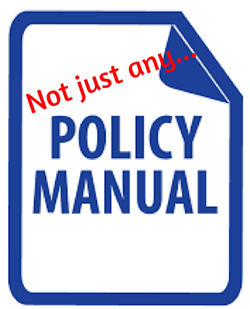
By David Lund
Having a policy manual that covers all the important aspects of your business that relate directly to the financial function is a mission-critical building block for your hotel company. Not too many people would argue with that statement.
Why then do most small hotel companies still not have a financial policy manual for its hotels and what do they need to do to create one? In this article, I will lay out why this project is on the backburner, how to construct a policy and a process for getting this project completed in short order.
There are two main reasons why the creation and completion of this policy manual are so elusive:
One, there is just no time. We are too busy buying hotels, repositioning them and running around from meeting to meeting to sit down and get serious about putting this manual together. Tomorrow is the word. But ultimately, we know tomorrow never comes. Things are changing so fast we do not have time to stop our world long enough to capture what should be the correct governance for our financial function. We know it is an important project but it never really gets to a boiling point, not to the point where we must act.
The main reason there is no time is that we do not make the time for it and – let’s face it – the COO and CEO are not exactly killing you daily because it is not done. It is kind of like your underwear drawer, out of sight and largely out of mind.
Two, there are just too many cooks. That is right, too many opinions and not enough certainty about all the various aspects of the operational minutia of your business. You know what it is like when we get 10 people together to discuss how we should do something. We get the 10 people in a room and we have 12 different ways to do the same thing. Everyone has an “opinion.”
“It's not about making the right choice. It's about making a choice and making it right.” ― J.R. Rim
This is where your leadership needs to pivot. You know all the noise and ideas are great but what you need is to leave the conversation at the right point and have concrete direction. With policies, it is important to be brief and concise. Stay away from the procedural aspect of the exercise. If the discussion is on the policy for the bank reconciliation, you do not want to slip into “how to do a bank rec.” You do want to state the purpose of the policy and the policy itself.
Something like this:
PURPOSE – To properly handle, control and process the monthly bank reconciliations.
POLICY – All bank accounts are to be reconciled by the 25th calendar day of the following month.
- The standard reconciliation from an Excel spreadsheet is to be used.
- A paper copy of the reconciliation is to be produced each month.
- Review and approval in writing are to be completed by the 25th of each month by the controller.
- All supporting documentation is to be included with the reconciliation and/or the location referenced for bank statements, outstanding deposits, outstanding checks and all adjusting entries.
- The reconciliation must be complete and all relevant documents that support the reconciliation must be attached or easily found via reference, i.e., bank statements.
- The reconciliation is not to be completed by any employee that has bank account signing authority.
- The reconciliation is not to be completed by anyone who prepares the bank deposit.
- All outstanding checks are to be reversed once they are 180 days old.
- All bank statements are to be mailed to the attention of the controller.
Here is a simple and straightforward way to get your policy manual project done and won. The motto for this project is “many hands make lite work.” Give your project a fun name, like “Mission Possible.” Get creative with this. Make it fun.
First thing, put together an inventory of policies that need to be incorporated in your manual. Just like you did in college, you are going to start with an outline of major topics to cover:
- Cash
- Inventory
- Payment Card Industry Compliance
- Etc., Etc., Etc.
In all, you want to have 25-40 different sections. Email me and I will send you a copy of my policy inventory outline and you can use it to get started.
Once you have the outline, add the names of the policies you want to write and include in the manual. Here is where you can get democratic and get the buy-in up front from others. Strike a policy committee from within your company’s structure. Include the relevant individuals you want and make sure you have good representation from the hotels and your corporate office. Eight to 12 people (not including you) is ideal.
Once you have the group put together, organize your first call. Prior to the first call, send the list of policy sections to each member. In the email tell the members that you will assign each participant two-three sections of the policy manual and ask them to think ahead which sections they would like to head up. Also, ask them to think about other important sections that might not have made your list. Request these additional section suggestions be emailed back to you before the first call.
Convene the first call and just prior to that call send out the latest enhanced inventory of policy sections. Include in the latest inventory of sections a player draft. In this draft selection, you have organized the players by your own last season points rank. The most junior or newest members get to pick their first section just like the major leagues do in sports. Complete the rotation until all the sections have been assigned. This should take about 15-20 minutes top. During this call, you can also review the purpose of the project and lay out a plan for the completion of the project.
Once all the sections have been chosen by the players, let them know the next step is for them to populate their sections with policy titles. The call the next week will be to have each team member submit their policy titles by section. One section at a time with no discussion or debate at this point. The goal is to get a first draft list of policy sections and policy titles. The second call should take no longer than 20 minutes. Have each member send you their policy names by section through email after the call.
In preparation for the third call, it is your job to get the list of policies consolidated. Here is where you take the lead and review, edit, discard and add policy titles. You communicate back to the individual owner of each section your approved list of policy names for their sections. This requires communication to each member ensuring they agree. They also get to hear from you firsthand on the policy project—especially the method for policy creation. Lay out the “purpose” and the “policy” template, framework and follow-up with each member and send them a policy sample like the one above for “bank reconciliation.”
This is the most critical step so far.
It is an essential step because you want to be very clear with each member on the structure for policy creation. Brief, concise, and not a lengthy procedure. Ensure each member has an opportunity to express their concerns and suggestions. Be open to new ideas and individual concerns. Have approximately 150 policies. If you have too many, consolidate some. It is essential that each team member owns their list of policies.
The third call is to share the edited list of policy sections and titles and the sample template. Prior to the call send the final policy sections and policy title list to each member and include their names with each corresponding section. At this point, you are turning over the creation of the policies to your team. You have organized the team, the list, and the standard template.
Using the math above with an average of 10 members who have 15 policies each to write you set up a schedule for 15 calls. I suggest you do not allow this to extend beyond 5 months or 22 weeks. With holidays, reporting schedules and other business it is important to lay out a calendar that makes sense. The format of these calls is each member presents one policy to the group by reading it. The members can add their verbal comments, suggestions, and ideas but the debate is limited to five minutes per policy.
You call the order of presenters and you are the timekeeper and gatekeeper. This call can be completed in one hour. The call is recorded and all members get the link after the call. Each week each member edits their policy and sends it to you for your final review and approval. If members cannot be on a call they have the responsibility of completing their policy and ensuring that another member will read it into the record. That member is still responsible to edit their policy and send it to you.
Just stick to the timetable and week by week you will assemble a great policy manual that your team complied. Ownership and pride in the result in less than 6 months. As the quarterback of this project, you need to make sure each member has their ball and that they stay on track week after week.
From this point, you have the makings of a powerful tool.
With this power tool policy manual, you can now create an Internal Control Review process. More on creating that in a future article.
If you would like a copy of any of the following send me an email at [email protected]
- Policy Inventory Outline
- F&B Productivity Spreadsheet
- Rooms Productivity Spreadsheet
- Financial Leadership Recipe F TAR W
- Flow Thru Cheat Sheet
Visit my website today for a copy of my guidebook
The Seven Secrets to Create a Financially Engaged Leadership Team in Your Hotel


